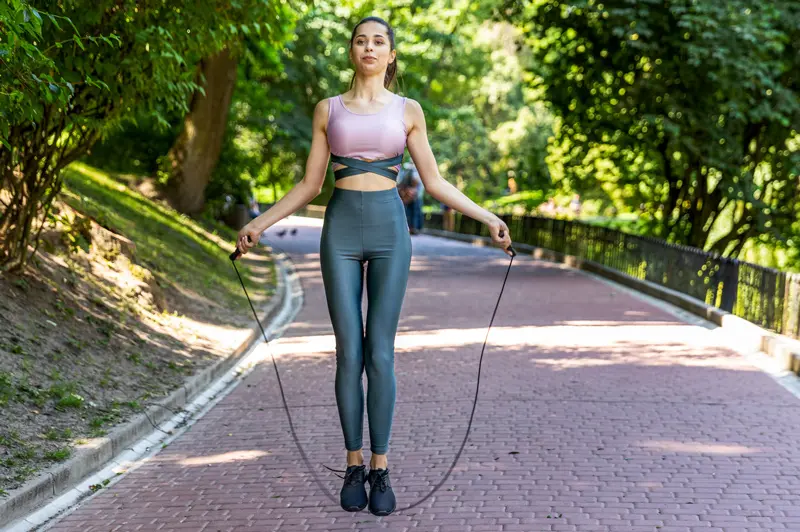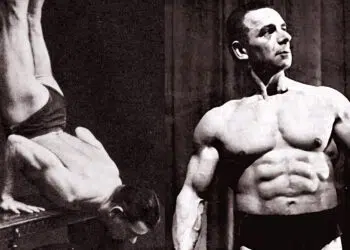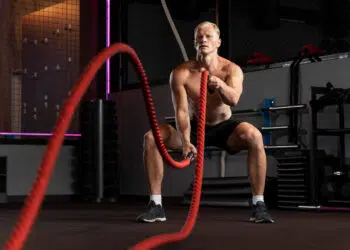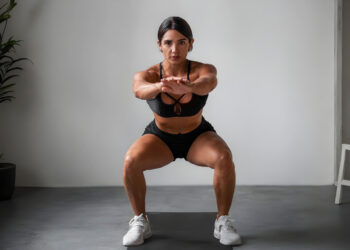High-Intensity Interval Training, HIIT for short, is one of the best ways to get fit, burn fat, and even build muscle. It’s incredibly time-efficient, and you can use it to cram a lot of beneficial exercise into a very short space of time (1).
Best of all, you don’t even need a gym to do it, and you can have a great HIIT workout in the confines of your home. All you need is a little space and maybe a mat for comfort. No mat? No problem – a folded towel will suffice.
This workout has been designed to work all of your major muscles while increasing your heart and breathing rate too. Use it whenever you need a fast-paced workout you can do at home.
Warming up for a great workout
A good workout starts with a thorough warm-up. Warming up prepares your body and mind for what is to come. A warm-up increases your core temperature, boosts blood and oxygen supply to your muscles, increases synovial fluid production in your joints, and also helps focus your mind. Warming up may also reduce your risk of injury.
Before attempting our equipment-free full-body HIIT home workout, get your body ready by doing the following warm-up.
Walk, jog, or jump rope for 5-10 minutes. Increase your pace gradually so that, by the end, you feel warm, slightly out of breath, and may even be sweating lightly.
Level Up Your Fitness: Join our 💪 strong community in Fitness Volt Newsletter. Get daily inspiration, expert-backed workouts, nutrition tips, the latest in strength sports, and the support you need to reach your goals. Subscribe for free!

Next, do 10-15 reps of the following dynamic stretching and joint mobility exercises:
- Squat push-press– squat down as far as you feel comfortable, and then, as you stand, reach up and overhead. Increase the depth of each squat as you start to feel warmer.
- Lunge and twist – step forward into a lunge and turn your upper body toward your leading leg. As with the squats, start off with a shallow range of motion and increase it as you get warmer.
- Step back and row– step back with one leg and push your heel down to the floor to stretch your calf. Simultaneously row your arms back at shoulder height to stretch and mobilize your chest and shoulders.
Finally, stretch any muscles that still feel tight. You should now be ready for your home HIIT workout!
Your equipment-free full-body HIIT home workout
This workout is made up of three three-exercise blocks. Each block involves an exercise for your legs, core, and upper body and takes no more than nine minutes to complete.
The entire workout, including your warm-up, should take about 40 minutes. Rest 1-2 minutes between blocks.
| Block one | Block two | Block three |
| 1. Reaching lunges | 1. Squat and squat jump | 1. Broad jump and shuffle back |
| 2. Plank jacks | 2. Step-throughs | 2. Flutter kicks |
| 3. Dive-bomber push-ups | 3. T push-ups | 3. Spider-man push-ups |
Block one:
Do three laps of the following exercises. Do each exercise for 45 seconds, and rest 15 seconds between each one.
- Reaching lunges
- Plank jacks
- Dive-bomber push-ups
Exercise instructions:
1 – Reaching lunges
This lunge variation works your quads, hamstrings, and glutes, but the addition of a forward reach increases posterior chain involvement and can also improve hip mobility. Like all types of lunge movements, this exercise is also good for your balance.
- Stand with your feet together, arms by your sides.
- Take a large step forward, bend your legs, and lower your rear knee to within an inch of the floor.
- Simultaneously, and without rounding your lower back, lean forward and down to touch your front foot.
- Push off your front leg, stand back up, and do another rep but leading with your opposite leg.
How to reaching lunges:
2 – Plank jacks
While there is nothing inherently wrong with regular planks, they are a static exercise, which means your heart rate may fall while you are doing them. That’s fine for general workouts, but not so good for HIIT. This exercise adds some extra movement to keep your heart rate elevated and also increase the workload on your abs.
- Lie on your front and rest on your forearms. With your feet together, lift your hips so that your shoulders, butt, and feet form a straight line. Brace your abs.
- Maintaining a tight core, jump your feet out to about shoulder-width apart and then jump them back in again. Do not let your hips drop.
- Keep breathing throughout this exercise, as holding your breath could increase your blood pressure.
How to pank jacks:
3 – Dive bomber push-ups
Dive bomber push-ups are good for your chest, shoulders, and triceps but, unlike regular push-ups, they will also improve your upper body and lower body mobility and strengthen your core too.
Level Up Your Fitness: Join our 💪 strong community in Fitness Volt Newsletter. Get daily inspiration, expert-backed workouts, nutrition tips, the latest in strength sports, and the support you need to reach your goals. Subscribe for free!
- Get down into a push-up position with your hands and feet shoulder-width apart. Lift your hips so that your body forms an inverted V.
- Keeping your shoulder down and away from your ears, bend your arms, and lower your chest forward and between your hands.
- Continue to move through as you straighten your arms and bring your chest up. Your hips will now be just above the floor. Imagine you just had to “dive bomb” your upper body under a low hurdle.
- Reverse this motion and return to the starting position.

Block two:
Do three laps of the following exercises. Do each exercise for 45 seconds, and rest 15 seconds between each one.
- Squat and squat jump
- Step-throughs
- T push-ups
Exercise descriptions:
1 – Squat and squat jump
The first move in this block is actually two exercises rolled into one. Why? Because bodyweight squats aren’t hard enough for most people, but 45 seconds of squat jumps are too hard. Mixing the two exercises together means you should be able to maintain a high work rate for the entire 45-second interval.
- Stand with your feet shoulder-width apart, toes turned slightly outward. Bend your knees and squat down until your thighs are roughly parallel to the floor. Stand back up.
- Next, descend again but, this time, jump up instead of standing. Land on slightly bent knees and do another regular, non-jumping squat.
- Continue alternating between squats and squat jumps for the duration of your set.
How to squat jumps:
2 – Step throughs
This dynamic core exercise works your abs and obliques and will also keep your heart rate elevated. It takes a bit of coordination, but once you’ve mastered it, you’ll love how effective this exercise is.
- Start on all fours with your arms straight and knees just off the floor.
- Kick your right leg under your body and out to the left as you lift your left hand off the floor to touch your right foot.
- Return to the all-fours position, keeping your knees hovering above the floor, and then repeat on the other side.
- Can’t reach your foot? No problem – just reach as far as you can.
How to step throughts:
3 – T-Pushups
T push-ups work your chest, shoulders, and triceps, but also provide your core with some extra work. In addition, this exercise will increase shoulder activation and stability.
- Adopt the push-up position with your arms and legs straight, feet together, and hands about shoulder-width apart. Brace your abs.
- Bend your arms and lower your chest to within an inch of the floor.
- Extend your arms and turn your upper body, lifting one arm off the floor and extending it vertically. Your entire body and supporting arm should be straight, too, so your body resembles a T-shape on its side.
- Return your hand to the floor, bend your arms, and then do another rep on the opposite side. Continue alternating arms for the duration of your set.
How to T-Pushups:
Block three:
Do three laps of the following exercises. Do each exercise for 45 seconds, and rest 15 seconds between each one.
- Squat, broad jump and shuffle back
- Flutter kicks
- Spiderman pushups
Exercise descriptions:
1 – Squat, broad jump and shuffle back
This exercise is designed to increase muscle power, which is your ability to generate force quickly. Power is an integral part of most sports, and this type of exercise is also useful for pumping up your heart rate.
- Stand with your feet shoulder-width apart. Squat down and swing your arms behind you.
- Jump forward as far as you can, using your arms for extra momentum. Land on bent knees to absorb the impact.
- Quickly stand up and shuffle back a few steps, returning to your take-off spot, and then repeat.
How to broad jump with shuffle back:
2 – Flutter kicks
This old-school classic exercise is much loved by the Special Forces, especially Navy SEALs. It’s not a complicated exercise, but it sure is effective!
- Lie on your back with your legs straight. Put your hands flat on the floor under your butt. Lift your head and shoulders a few inches off the floor and lift your feet too.
- Keeping your legs up, kick them as though you were swimming. Keep your lower back pressed into the floor and your abs braced throughout.
How to flutter kicks:

3 – Spiderman pushups
While we can’t promise you’ll be climbing the walls like Peter Parker anytime soon, this exercise will increase your upper body strength and endurance and your lower body mobility. It gets its name because, from above, you’ll look like you are crawling up a building.
- Adopt the push-up position with your arms and legs straight, hands around shoulder-width apart.
- Bend your arms and lower your chest to the floor. Simultaneously bend one leg and pull your knee out to the side and up to your elbow.
- Extend your arms, straighten your leg, and do another rep on the opposite side.
- Alternate sides for the duration of your set.
How to spiderman pushups:
FAQs
Do you have any questions about this workout? We’ve got answers! If you can’t find the information you are looking for below, drop us a line in the comments section, and we’ll get back to you as soon as we can.
Do I HAVE to warm up before this workout?
While you could skip the warm-up, we don’t recommend it. Warming up will help ensure your body is ready to train, and you should also find that you perform better after a warm-up. And while there is no guarantee that you won’t injure yourself while you exercise, as sometimes injuries just happen, warming up should lower your risk.
How can I make this workout easier?
There are a few things you can do that will make this workout easier while staying true to the basic format.
- Adjust the work to rest periods. If 45 seconds of exercise is too long and 15 seconds rest is not enough, feel free to do something like 35/25, 30/30, or even 20/40.
- Work at a slower pace. If you are new to this kind of workout, slow down and do fewer reps per set. Pacing yourself will make things more manageable.
- Use easier versions of the prescribed exercises. Drop to your knees for push-ups, omit any jumps, or look for other ways to make the listed exercises easier. You could also do different exercises so long as they work the same muscle groups.
- Do fewer laps. You could do just two laps instead of three.
I can’t do/don’t like some of the exercises. Can I do something else?
If you find an exercise hard, you should try and stick with it, so you get better at it. In a lot of cases, we don’t like doing the things we find hard, but it’s those very things that we need to do more of! When it comes to effective exercise, harder is usually better.
But, if doing an exercise hurts, or you are unable to do it properly, feel free to replace it with another. Just make sure you stay true to the spirit of the workout by using similar exercises and, for example, not replacing a lower body exercise within one for your core. Keep to the legs/core/upper body sequence.
How often can I do this workout?
If this is the only workout you do, there is nothing wrong with doing it three times per week on non-consecutive days, e.g., Monday, Wednesday, and Friday. You could even do it just twice a week, such as on Monday and Thursday. But, if you do other types of exercise, such as strength or sports training, you may only need to do this workout once per week. Adjust workout frequency to suit your energy levels, needs, and goals. You can also adjust your workout frequency based on the information in this article.
How can I avoid muscle soreness after this workout?
One of the best ways to minimize muscle soreness after exercise is to spend a few minutes cooling down and stretching once you have finished. Simple do another 3-5 minutes of easy cardio and then statically stretch the muscles you have just been working. Consuming some fast-acting carbs and protein may also help. Finally, avoid doing too much exercise too soon as overexertion is the leading cause of post-workout muscle soreness.
Wrapping up
There is no need to lose fitness or gain weight just because you can’t or prefer not to go to the gym. Your body weight is all you need. Use this home bodyweight HIIT workout to increase tour endurance, burn calories, and stay in shape in the comfort of your home. Providing you work hard, it will produce many of the results you can get from gym training. Whatever your fitness goals may be, this workout can help!
References:
- PubMed: High-intensity interval training for health benefits and care of cardiac diseases – The key to an efficient exercise protocol https://www.ncbi.nlm.nih.gov/pmc/articles/PMC6763680/








